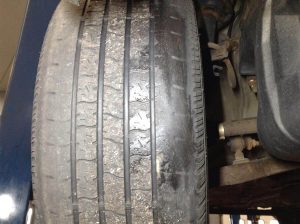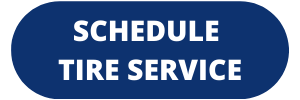Common Signs of Irregular Tire Wear
 Irregular tire wear can be indicative of a serious problem. There are several types of irregular wear. The most typical ones are heel and toe wear, one side wear, center wear, and flat spots. Here are a few of the most common signs to look out for for each:
Irregular tire wear can be indicative of a serious problem. There are several types of irregular wear. The most typical ones are heel and toe wear, one side wear, center wear, and flat spots. Here are a few of the most common signs to look out for for each:
Heel and Toe Wear
Also called “saw-tooth” wear, this pattern is caused by normal usage with normal suspension settings. Cross-grooves in the tire, for water drainage on wet and flooded roads, form “freestanding blocks” in the shoulder area. These freestanding blocks deform and are compressed as they come into contact with the road. As they lose contact with the road, they snap back to their original shape and “rub” the surface of the road creating wear. A minor amount of “saw-tooth” pattern wear is normal and has no discernible effects on comfort. This wear pattern is more likely to occur on non-driven wheel positions. More conspicuous wear of this kind points to specific operating conditions (improper inflation, excessive toe-in, low-wear applications). In order to gain even tire wear, tires should be rotated at regular intervals (unless otherwise recommended by the vehicle manufacturer).Center Wear
This wear pattern is found on the driving wheels of highly motorized cars. Engines that generate high levels of torque can quickly increase wear on the tread center, especially during strong acceleration, in stop-start urban traffic, or when accelerating away from traffic lights. Periodically rotating the wheels from the powered axle to the non-powered axle can help you obtain a largely uniform pattern of wear. And, as always, observe the vehicle manufacturer’s recommendations for best results.One-Sided Wear
The most frequent cause of one-sided tire wear is a deviated axle. These can develop over time and can be the consequence of, for example, driving over curbs. Owners of vehicles with customized suspensions may also find that the modified suspension arms encourage a tendency for the alignment to deviate. This may go unnoticed for some time, if the wheel alignment values are within tolerance limits, but can cause an increase in non-uniform wear. If a vehicle’s wheels are misaligned, the wheels must be aligned and the deviation corrected, to prevent this irregular wear.At V&F
It’s important to check your tires regularly for irregular wear and other exterior damage such as cuts, cracks, or bulges. If you do discover or suspect damage, have the tire inspected by a tire service professional. Call us today at (413) 314-2280 or schedule an appointment online. This article was originally published in 2018 and has been updated.
This article was originally published in 2018 and has been updated. 